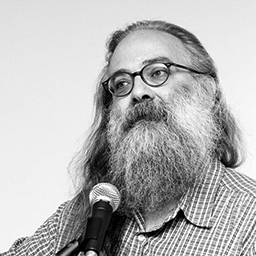
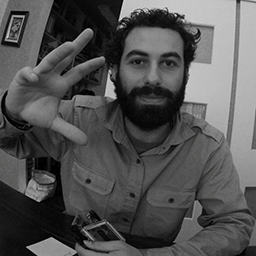
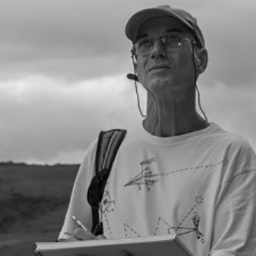
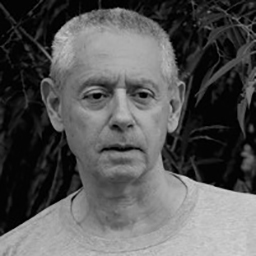
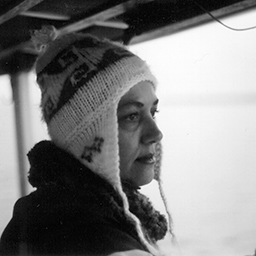
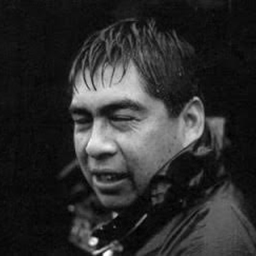
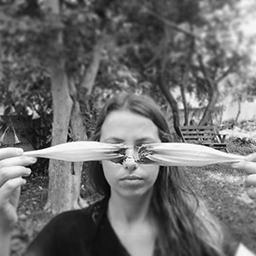
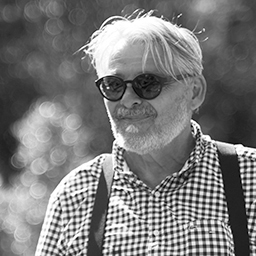
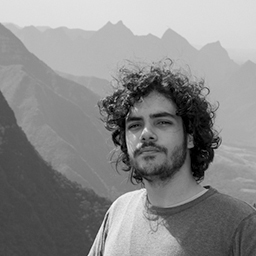
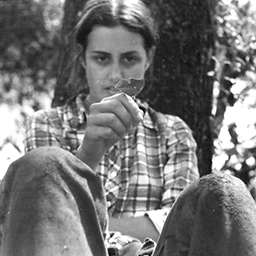
Chris Daniels (NYC, 1956) translated all the texts in On the glittering screen of the eyelids into English. He moved to the San Francisco Bay Area in 1980, and currently lives in Oakland. Publications include: The Collected Poems of Alberto Caeiro, by Fernando Pessoa, and The Collected Poems of Álvaro de Campos, by Fernando Pessoa, vol. 2 (both published by Shearsman Books; vol. 1 of Campos is in preparation); On the shining screen of the eyelids, by Josely Vianna Baptista (Manifest Press); a self-published, fascicular anthology of Lusophone poetry, distributed privately in the form of modest chapbooks; and porous, nomadic, a long poem-in-progress published by Airfoil (David Abel and Sam Lohman) in Portland, OR. His translations have appeared widely in print and online journals in the US and other countries.
Guilherme Vianna Baptista (Londrina, 1988) created the Map of Campos Gerais do Paraná especially for this project. Bachelor’s degree in Geography with emphasis on Geotechnology at Universidade Tuiuti do Paraná, where he developed the project “Espacialização e Identificação de Áreas de Instabilidade de Encostas no Distrito de Bateias, Município de Campo Largo-PR” (2008-2011). Developed and participated in diagnostics, execution and monitoring of environmental programs, using geoprocessing as a tool for analysis and presentation. Laboratory and fieldwork for Envlab (2008), Emater – Instituto de Pesquisa e Extensão Rural (2009-2010), Consiliu Meio Ambiente e Projetos (2011), CIA Ambiental (2012), Ygaribá (2013) and Elo Consultoria Ambiental (2014), Embrapa Florestas (2015). Worked on the projects “Retratos do Belém – a trajetória de um rio urbano” and “A Estrada do Assungui – Caminhos históricos de Curitiba” (Oficina Projetos, 2012).
Guilherme Zamoner Neto (Londrina, 1951) made all the drawings in Vila Velha, Guartelá: in immemory’s aerial sands, the word light carved on stone, and is art director for On the glittering screen of the eyelids. He is an architect, draughtsman, engraver and graphic artist, and has been represented in exhibitions like Primeira Mostra da Ilustração Paranaense (MAC/Paraná); V Festival de Inverno de Ouro Preto (1st Prize); Arte P&B/Gold medal, and Coletiva de Gravadores/85 (FCC). He was one of the Paranaenses represented in the exhibition "Arquitetos Brasileiros" (Galerie d'Actualité de l'Institut Français d'Architeture, Paris). He illustrated O Gato Peludo e o Rato-de-Sobretudo (Wilson Bueno) and A Concha das Mil Coisas Maravilhosas do Velho Caramujo (2001, VI Prémio Internacional del Libro Ilustrado Infantil y Juvenil do Governo do México), among others. He has been the art director and creator of dozens of book designs: Krajcberg (with Oswaldo Miranda, 1984), Nakta, by Miguel Rio Branco (FCC, 1996), A Arte de Loio-Pérsio (Curitiba, 1997), Brasilianische Kunst Aus Paraná in Berlin (2002), Brennand, o Homem e a Natureza (MON, 2003), Os Modernos Brasileiros +1 (MON, 2008; architecture, ambience and graphics), and 50 anos da Panamericana, Arte e Design (graphic project in partnership with Oswaldo Miranda, Miran, 2013). Other of Zamoner’s works can be seen at: http://guizamoner.wix.com/guiz.
José Kozer (Havana, 1940) collaborated with Josely on the book-palimpsest On the glittering screen of the eyelids. The son of Jewish parents who emigrated to Cuba (Czech mother, Polish father), Kozer has lived in the US since 1960. He taught Spanish language and literature at Queens College, CUNY, from 1965 to 1997, and is the author of 75 books of poetry. Segments of his work has been and continues to be translated into various languages, and published in numerous reviews and periodicals. His work has been the subject of MA and doctoral theses. Among his recent books: Bajo este cien (México e Barcelona), Carece de causa (Buenos Aires), Ánima (México), No buscan reflejarse (Havana), Farándula (México), Tokonoma (Madri), Índole (Matanzas, Cuba), De rerum natura (São Paulo) and two books of prose, Mezcla para dos tiempos e Una huella destartalada (México). Visor Editores (Madrid) recently published a large selection of his work entitled Y del esparto la invariabilidad; Monte Ávila (Caracas) published another selection entitled Trasvasando. Ánima was published in England in a bilingual edition with Peter Boyle’s translations; Peter Boyle also translated Tokonoma (originally published by Amargord, in Madrid); his translation was published in a bilingual edition by Shearsman Books; the second edition of the book contained only the translation. He received 2013’s Prêmio Iberoamericano de Poesia Pablo Neruda, and, also in 2013, Fondo de Cultura Económica published a retrospective of his work entitled Acta est fabula. He lives in Hallandale, Flórida.
Josely Vianna Baptista (Curitiba, 1957), creator and editor of this project, is the author of the poems in On the glittering screen of the eyelids, Vila Velha, Guartelá: in immemory’s aerial sand, the word light carved on stone, and Nothing is image, nothing is mirage. Her publications include Ar and Corpografia (Iluminuras, 1991/92), A Concha das Mil Coisas Maravilhosas do Velho Caramujo (Mirabilia, 2001, ilust. G. Zamoner – VI Prémio Internacional del Libro Ilustrado Infantil y Juvenil do Governo do México), On the shining screen of the eyelids (Manifest, 2003, trans. Chris Daniels, Creative Work Fund – Literary Award, Walter and Elise Haas Fund, San Francisco), Florid pores (in 1913. A journal of forms. Roanoke, 2006, trans. Daniels e Alfarano), Sol sobre nuvens (Perspectiva, 2007, presented by Augusto de Campos), Roça Barroca (Cosac Naify, Prêmio Jabuti de Poesia). In 2009, specimens of her work were included in The Oxford Book of Latin American Poetry (NY, Oxford University Press. Org. E. Livon-Grosman and C. Vicuña). She created the Cadernos da Ameríndia collection. As a translator of Hispano-American literature, she has produced Portuguese translations of Roa Bastos, Lezama Lima, Onetti, Arguedas, Cortázar, Cabrera Infante and Borges (Prêmio Jabuti de Tradução), among many others. Beginning in 1992, she has developed an ongoing work with Francisco Faria; their collaboration builds a close relationship between poetry and the visual arts. She lives on Ilha de Santa Catarina.
Leonel Lienlaf (Alepue, Chile, 1969) contributes to this project with “The river of the sky”. A bilingual poet (Mapudungun/Spanish), he began to write when he was about 10 years old, influenced by his grandmother, Marcelina Pichún, from whom he says he learned everything about the Mapuche vision of the cosmos and their oral poetry. Also a musician and researcher, he is the author of Canto y poesía mapuche (Biblioteca Virtual Miguel de Cervantes, 2000 – digital sound recording based on recordings made in Santiago de Chile, Dibam, Finnish Embassy, 1997), Palabras soñadas –Pewma Dungu (LOM Ediciones, Santiago, 2003), and Kogen (Temuco, Del Aire Editores, 2014), among others. In collaboration with Carlos Aldunate and Pedro Megge, he carried out the research project “Etnosemiótica de la literatura oral mapuche” for the Chilean Museum of Pre-Colombian Art (1992), as well as “Relatos orales en comunidades mapuches del sector de la costa valdiviana” and “Memoria oral campesina de la zona Talagante”. He contributed to the creation and completion of the project Elaboración de módulos literarios con énfasis en poesía mapuche, for teachers in primary education (together with the Pontifícia Universidad Católica de Chile). He was the first Mapuche poet to receive the Prêmio de Literatura de Santiago, in 1990, for his book Se ha despertado el ave de mi corazón (Editorial Universitaria, 1989). Two of his books await publication: Kütralhue (Desde del fogón) and Historia de aguas.
Maria Baptista (Londrina, 1982). Producer of On the glittering screen of the eyelids. Creator of the video Nothing is image, nothing is mirage. Degree in Architecture and Urbanism from UFPR (2000-2005); studied Sculpture at Escola de Belas Artes do Paraná (2010-2011) and Specialization in Visual Poetics at the same school (2014-2015). Produces photographic essays and research into three-dimensional language with production of objects, installations, and experiments in environmental art. www.gutabap.blogspot.com.br. Since 2005, she has directed Oficina Projetos Culturais, where she realizes works of architecture, exhibition design, scenography, visual communication, and cultural production. www.oficinaprojetos.blogspot.com. She lives and works in Curitiba.
Miguel Gaissler (Curitiba, 1952) was the consultant for this project, especially for the Brief historic and geographic glossary of Campos Gerais, Paraná. Historian and archeologist educated at UFPR, he has done extensive archeological research in Brazil, such as Projetos Arqueológicos Itaipu, Foz do Areia e Vila Rica do Espírito Santo (Fund. Pró-Memória/Museu Paranaense), Arqueologia Histórica nos Campos Gerais (Museu Paranaense/Sec. do Patrimônio Histórico e Artístico Nacional/Prefeitura de Piraí do Sul), Diagnóstico arqueológico para planos de manejo do Parque Estadual do Guartelá, Levantamento de pinturas rupestres no Arenito Furnas (Fund. Nacional Pró-Memória/Itupava Ltda), among others just as important. In 1980 he coordinated Setor de Arqueologia do Museu Paranaense, of which he was Director from 1983 a 1987. He represented Paraná at the Conselho Nacional de Museus/Sec. do Patrimônio Histórico e Artístico Nacional. He is the expert for Ministério Público na Reserva Indígena de Mangueirinha for the Projeto Arqueológico de Mangueirinha. He was an advisor for Patrimônio Histórico e Artístico Nacional (MinC) and for Conselho Internacional de Monumentos e Sítios – Brasil – ICOMOS/UNESCO.
miguelgaissler@yahoo.com.br
Pedro Jerônimo Vianna Baptista Vaz de Faria (Curitiba, 1997) created the photographic triptych The tree of the Ridge. He photographically documentated the project On the glittering screen of the eyelids, recorded the collaborators at work in the field, and arranged the photographic mosaics illustrating the Brief historical and geographical glossary of Campos Gerais, Paraná. In 2015, he enrolled at Universidade Federal de Santa Catarina, where he is studying Electrical Engineering. As assistant to the artist Francisco Faria, he documents the artist’s works and activities, including expeditions to remote parts of the Brazilian tropical forest and the Mata Atlântica. Voluntary undergraduate fellow in Chemistry (natural compounds) at the Laboratório de Estrutura e Atividade (LEAT), Chemistry Department, Federal University of Santa Catarina. Member of Tarrafa Hacker Club, a communal lab dedicated to collaborative action in technology, music, digital art, and electronics. At the same university, he participates in Observatório Latino-Americano, a discussion and research group focused on classics of Latin American critical thought. He lives in Florianópolis.
Vera Regina Biscaia Vianna Baptista (Curitiba, 1954). Author of the Brief historic and geographic glossary of Campos Gerais, Paraná. Historian at Universidade Federal do Paraná and specialist in Museology at Escola de Música e Belas Artes do Paraná, she has participated in several research projects concerning Paraná’s cultural and artistic heritage.She is the author of A Arte de Loio-Pérsio (Fundação Cultural de Curitiba, 1999) and Ruínas de São Francisco: dois séculos de história e mito (Fundação Cultural de Curitiba, 2004), She collaborated on the book Curitibanos dos Campos Gerais, by Vera Maria Biscaia Vianna Baptista (FCC/Mirabilia, 2002) and Guido Viaro, um visionário da arte, by Maria José Justino (Editora do Museu Oscar Niemeyer, 2007). From 1995 to 2002, she worked in the Setor de Pesquisa e Documentação do Museu de Arte do Paraná. Since 2003, she has been working as a researcher at the Museu de Arte Contemporânea do Paraná, where she is also part of the Conselho Consultivo and is in charge of documentation for the museum’s archive.